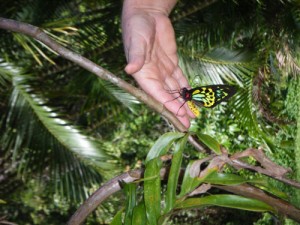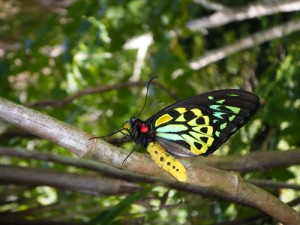
When it comes to BIG butterflies you don’t get better than the Birdwing Butterfly (Omithoptera priamus) or the Cairns Birdwing. Yes, the people of Cairns have named this spectacular butterfly their very own! It is the largest species of butterfly found in Australia. The female has a wingspan of a whopping 15cm, even if she is a little duller, black and white with a touch of yellow, than the male with his showy green, gold and black. They are a little more laid back than the more frantic Ulysses with a slower, more relaxed flight. Cairns Birdwing Butterfly can live for 4-5 weeks.
The males are pretty predatory when it comes to mating and patrol their territory in the early morning, searching for newly emerging females. It’s not all easy – he then has to cope, rather precariously, with a great deal of competition from other patrolling males who have invaded his territory. The battle is worth winning with a coupling lasting for up to 36 hours.
The females, who are often mated as soon as they emerge from the cocoons, start early setting a territory around the vigorously leafed vine of the Aristolochia where they prefer to lay their eggs. The female is able to locate the correct plant by using chemical receptors in her forelegs to taste various leaves. She also uses sense organs at the end of her abdomen to find tender leaves that would be suitable for caterpillar food. Unfortunately the one plant that can fool her is Aristolochia elegans a similar introduced species that the larvae will also feed on, which is toxic, and this leads to the death of the larvae.

The leaves of the Aristolochia vine is poisonous and though nutritious for the Birdwing caterpillar, is deadly to many other caterpillars. For the Birdwing caterpillar it is not only nutrition but by storing the toxins in fleshy orange-red spines on their backs, it is also protection. Bright colours, in nature, such as orange, red and yellow sometimes act as warnings to other animals letting them know they are dangerous or inedible.
When the caterpillars of the birdwing butterfly are almost ready to pupate they ringbark the vines on which they are feeding. The leaves then droop due to water loss, but the flow of nutrients to leaves is the same – the large caterpillar gets more nutrition with less water before pupation!
